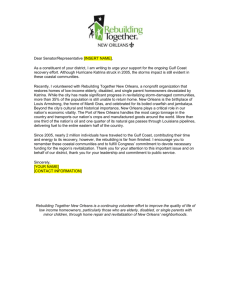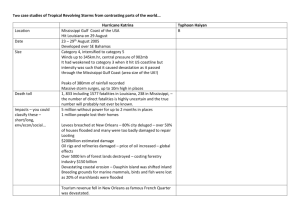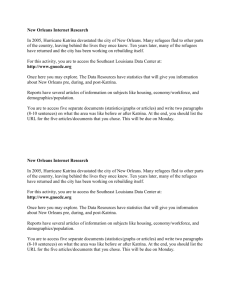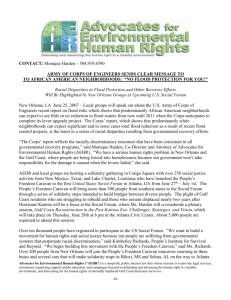Memory of the Flood
advertisement
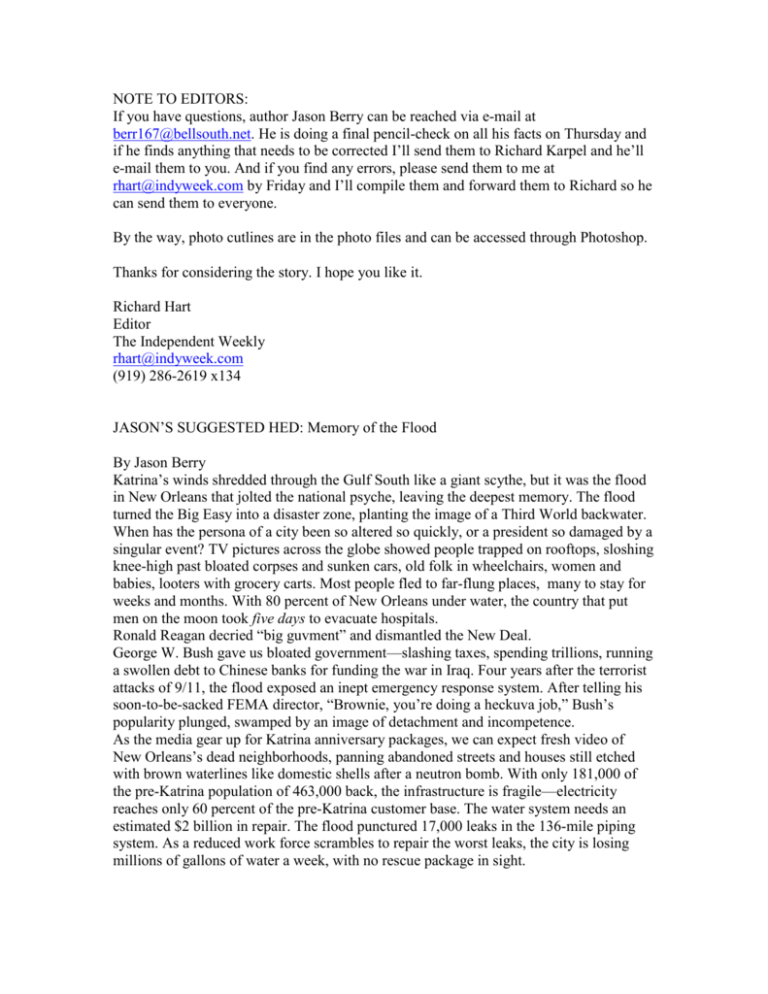
NOTE TO EDITORS: If you have questions, author Jason Berry can be reached via e-mail at berr167@bellsouth.net. He is doing a final pencil-check on all his facts on Thursday and if he finds anything that needs to be corrected I’ll send them to Richard Karpel and he’ll e-mail them to you. And if you find any errors, please send them to me at rhart@indyweek.com by Friday and I’ll compile them and forward them to Richard so he can send them to everyone. By the way, photo cutlines are in the photo files and can be accessed through Photoshop. Thanks for considering the story. I hope you like it. Richard Hart Editor The Independent Weekly rhart@indyweek.com (919) 286-2619 x134 JASON’S SUGGESTED HED: Memory of the Flood By Jason Berry Katrina’s winds shredded through the Gulf South like a giant scythe, but it was the flood in New Orleans that jolted the national psyche, leaving the deepest memory. The flood turned the Big Easy into a disaster zone, planting the image of a Third World backwater. When has the persona of a city been so altered so quickly, or a president so damaged by a singular event? TV pictures across the globe showed people trapped on rooftops, sloshing knee-high past bloated corpses and sunken cars, old folk in wheelchairs, women and babies, looters with grocery carts. Most people fled to far-flung places, many to stay for weeks and months. With 80 percent of New Orleans under water, the country that put men on the moon took five days to evacuate hospitals. Ronald Reagan decried “big guvment” and dismantled the New Deal. George W. Bush gave us bloated government—slashing taxes, spending trillions, running a swollen debt to Chinese banks for funding the war in Iraq. Four years after the terrorist attacks of 9/11, the flood exposed an inept emergency response system. After telling his soon-to-be-sacked FEMA director, “Brownie, you’re doing a heckuva job,” Bush’s popularity plunged, swamped by an image of detachment and incompetence. As the media gear up for Katrina anniversary packages, we can expect fresh video of New Orleans’s dead neighborhoods, panning abandoned streets and houses still etched with brown waterlines like domestic shells after a neutron bomb. With only 181,000 of the pre-Katrina population of 463,000 back, the infrastructure is fragile—electricity reaches only 60 percent of the pre-Katrina customer base. The water system needs an estimated $2 billion in repair. The flood punctured 17,000 leaks in the 136-mile piping system. As a reduced work force scrambles to repair the worst leaks, the city is losing millions of gallons of water a week, with no rescue package in sight. 2 Nevertheless, $8 billion in federal funds will soon hit the streets, earmarked for homeowners and businesses that lacked sufficient insurance to rebuild or recoup some of their losses. There is a shadow-story to this devastation that reaches across the country. In exposing the shoddy system of federal emergency preparedness, the New Orleans flood highlights a far greater crisis: the impact of climate change. SUBHED: What the heat means Katrina was a billboard for global warming. For years, emissions from fossil fuels used by industry and automobiles sent carbon dioxide into the atmosphere that allowed sunlight in but kept heat from escaping, creating what's been called a greenhouse effect. As a scientific consensus emerged, Al Gore, then a U.S. Senator, made global warming a political issue. Today’s Congressional majority under Bush scorns the issue. Sen. James Inhofe (ROklahoma) calls global warming “the greatest hoax ever perpetrated on the American people.” For years, ExxonMobil has engaged in a shameful disinformation campaign to discredit the scientific findings. With no hint of irony, Inhofe calls global warming “the big lie,” comparing the science behind it to Nazi propaganda leading up to World War II. An Inconvenient Truth, the film based on Gore’s ongoing lectures (and the title of his companion book), shows stark scenes of glaciers crumbling and the browning of Mt. Kilimanjaro in Tanzania—gone are the snowcaps Hemingway adored. As gases from burned fossil fuels accumulate in the atmosphere, a long melt is under way in Greenland and Antarctica. The melted ice causes seas to rise. As seas rise, so do their temperatures rise in hot months. Hotter air and warmer water ignite more powerful storms. (Inhofe told the Tulsa World that every claim in the documentary “has been refuted scientifically,” although he conceded he had not seen the film.) The hottest year on record, 2005, saw the greatest concentration of hurricanes with record winds—Katrina, Rita and Wilma. But the summer of 2006 has brought continuing destruction, only more spread out. “We’d have to go back over three decades to find anything comparable to the flooding we’re seeing in the Northeast,” a National Weather Service meteorologist named Dennis Feltgen told USA Today in late June. He was referring to the wash of destruction in New York, Pennsylvania, Delaware and Virginia. Perhaps the most chilling scene in An Inconvenient Truth is an aerial map of Manhattan turning blue-green from flooding. Don’t laugh. One hard turn from a Cat 3 hurricane and the Big Apple could be a mess. A mild version of that scenario happened in December 1992 when a northeasterly storm sent sea level up eight feet at the southern edge of Manhattan Island. LaGuardia Airport had to close, the Brooklyn tunnel flooded, and the subway system shut down. Perhaps those memories, coupled with TV coverage of Katrina, explains why people in Manhattan are buying flood insurance. At present, only 28 percent of homes in the Northeast carry flood insurance, compared to 49 percent nationwide, in areas that are considered high-risk. In his new book, The Ravaging Tide, Mike Tidwell writes that a rise in sea level of one to three feet will have an impact on “every inch of American shoreline from the Texas coast 3 to the Florida Keys to the Outer Banks of North Carolina to Cape Cod. The low-lying areas of San Diego and San Francisco and much of Puget Sound on the West Coast are at great risk too.” He cites an EPA study in saying that “no fewer than one in four U.S. buildings within five hundred feet of a coastline will be destroyed by erosion by midcentury.” Flooding is America’s most common natural disaster. In the decade before Katrina, flooding caused $7.1 billion in losses to homes and businesses. As the intensity and frequency increase, the average 30-year mortgage has a 26 percent chance of taking damage from rising water, compared to a four percent chance of fire. As more people buy flood insurance, the financial pressure on the federal government—which backs flood insurance—will escalate in kind. “Hurricane Katrina’s $23 billion [insurance] hit has triggered a full-blown debate about the federal program that insures property in flood-prone areas,” author Neil Peirce wrote recently in Stateline.org. “Critics are charging the program’s rates are so cheap and its loopholes so broad that it actually puts pressure on local governments to permit new development in extraordinarily flood-prone areas—territory that should never be built on in the first place.” The social Darwinists who control Congress have aped Bush’s What-Me-Worry? attitude on environment. “Defense” has meaning only in a military, not environmental, sense. The planet’s revenge doesn’t compute. But as scientific data mounts, smarter people are taking a harder, deeper look. “Britain’s largest insurance company, CGNU, in 2002 predicted that unchecked global warming could bankrupt the entire global economy by 2065,” reports Tidwell. “A key threat highlighted by the insurer was sea-level rise that would directly destroy valuable land, buildings and agricultural assets while indirectly exposing everything farther inland to more intense storms expected in a warmer world.” SUBHED: Lessons from the water line Human error produced the New Orleans flood—huge flaws in Mississippi River levee projects built by the U.S. Army Corps of Engineers and environmental negligence by government and oil companies that caused wetlands south of the city to erode. The lost wetlands gave tidal waves an open alley to the city. But the dynamics of this failure are national in scope. “The cost of a collapsing coast is one of fundamental survival,” says Mark Davis, director of the Coalition to Restore Coastal Louisiana in Baton Rouge, a group that has worked on the issue for years. “What happened last year was also the failure of a value system. We assumed we had tamed the forces of nature. We need to understand that if we want there to be a New Orleans, or a Los Angeles, or a Miami, or a New York, 500 years from now, we can’t assume they’ll be there. We have to plan for them to be there. That’s why the rise in sea levels and freshwater management are so extraordinary.” As Davis runs down a list of other cities—including San Francisco, Orlando and Atlanta—where rapid growth has overwhelmed environmental-defense planning, it is worth noting that FEMA considers New Orleans, Miami and New York as the cities most vulnerable to hurricane disasters. More than a third of the 167 hurricanes that struck America in the last century hit Florida. Miami is about three feet above sea level, with a vast wetlands complex to the west. Beachfront development and a building boom have 4 packed the area with people. If the ocean levels continue to rise, the area’s marshy buffer won’t be enough to halt a massive flood. That is what happened to New Orleans. In the 24 hours before Katrina made landfall, the storm doubled in size, blanketing waters “of the Gulf equal in area to California,” report John McQuaid and Mark Schleifstein in another new book, Path of Destruction. As the Category 5 storm with 175 mph winds neared Louisiana, winds dropped to 127 mph, a Category 3 level, still strong enough to produce huge waves. Katrina hit early on Monday, Aug. 29. The eye flattened the coastal town of Buras, sending thunderous waves across villages and hamlets south of the city, tossing cars and boats onto trees and roofs. Winds roared through Lake Borgne, pushing waves 20 feet high. The giant water sheets rolled toward New Orleans East on a passageway between man-made canals. One side of the vast lane straddles a levee along the Gulf Intracoastal Waterway; the other levee hugs the eastern side of the Mississippi River Gulf Outlet, known locally as MR-GO (pronounced, without a trace of irony, “mister go”). “The funnel,” where the Intracoastal and the MR-GO meet, sent water throttling between and over the tops of those levees and into the city as well as nearby St. Bernard Parish— the end result of decades of dredging by the Corps of Engineers. Building MR-GO destroyed 20,000 acres of marshland in the 1960s. Junior Rodriguez, the barrel-chested president of St. Bernard Parish, railed against MR-GO for years. As the Corps dug the alternate shipping lane for moving cargo from the Mississippi to the Gulf, the dredging opened an artery 500 feet wide. MR-GO was finished in 1963. The Lower Nine and St. Bernard Parish were destined to flood because of MR-GO. Even Louisiana’s Republican Senator, David Vitter—who before Katrina promoted legislation to allow commercial destruction of cypress trees—has come around to saying that the 76mile canal should be closed. Such a move would allow for some of the lost wetlands to be restored. Yet alongside the Corps’ mistakes and FEMA’s incompetence, the city bears a measure of blame. The city’s levee district in the early 1980s pressed the Corps to confine its design scope to a 100-year hurricane defense, which meant the city would pay proportionally less for its cost-share of levee work, thereby freeing funds for lakefront development. The Corps wanted to build canal floodgates in the lake, which might have prevented flooding in much of the city. The flooding put in sharp relief a central challenge to south Louisiana’s survival: coastal erosion and how to remake wetlands as a protective buffer to Gulf hurricanes. The damage was chronicled by Times-Picayune reporters Schleifstein and McQuaid in a 2002 series, by Mike Tidwell in his 2003 book, Bayou Farewell, and by Christopher Hallowell in his 2001 book on wetlands loss, Holding Back the Sea, among others. The land south of New Orleans has been sinking as Gulf waters rise. Tidwell found fishing communities with submerged cemeteries, people whose property had disappeared into the Gulf. A million acres of wetlands have been swallowed by the Gulf, eroding nature’s defense against hurricane tidal waves, opening a destructive path to the city. Louisiana Gov. Mike Foster (1996-2004) gave petrochemical industries an easy ride for toxic waste disposal, treating his Department of Environmental Quality like a serfdom. But Foster, a bluff, Falstaffian fellow, liked the great outdoors and became concerned about coastal erosion thanks to a cross-section of business people, fishermen, industrialists, state officials and ecologists who collaborated on a long report in 1998 5 called Coast 2050: Toward A Sustainable Coastal Louisiana. Foster gave George W. Bush copies of Hallowell’s and Tidwell’s books. There is little evidence that he read them. Coastal 2050 estimated it would cost $14 billion to restore the lost wetlands—big money, but a fraction of the $200 billion in estimated losses from Katrina. In 2004, Bush cut the Army Corps’ funding request for levee maintenance by more than 80 percent. Louisiana’s southern parishes are sinking—just as other rural and metropolitan areas along the Atlantic coast will effectively sink as ocean levels rise. For now, the Louisiana case is more severe; it stems in part from 20,000 miles of pipelines that criss-cross the coastal floor to deliver oil and gas from offshore rigs. Another factor for the mass sinkage is the impact of levees built by the U.S. Army Corps of Engineers developed in response to the Great Flood of 1927. Containing the Mississippi’s currents with stronger levees kept the city safe from the river but bottled up diversionary outlets, which drove streams of river silt like a chute into the Gulf rather than letting the sediment generate sluiceways to replenish tidal marshes. Starved of river nutrients, gouged by pipe excavations, the wetlands eroded and lower Louisiana began sinking in the process. Nearly 25 percent of all the oil and gas consumed in America travels through Louisiana's wetlands. Roughly a quarter of the nation’s seafood was generated from Louisiana’s coastal area before Katrina. Since 1932, the state has lost 1,900 square miles of wetlands, an area larger than Rhode Island. Ten square miles disappear annually. SUBHED: Congress and the flood “A relief bill passed by the GOP House in March managed to omit critical funds for battered levees,” The New Republic editorialized Aug. 8. “At times, negotiations stalled because some Republicans tried to divert Katrina relief away from Louisiana.” Yes, indeed. The social Darwinists who control Congress see New Orleans as expendable, an outer edge of the Third World. This mentality among Christian triumphalists who fueled the GOP resurgence stands in jagged contrast to the scores of churches from red states that sent members to the muddy blue city at the bottom of America, gutting houses, cleaning streets, helping people recover. The Christian triumphalists bought into a Faustian bargain with Bush on the environment. As the administration withdrew from the Kyoto treaty and gutted EPA, so many sheep-like Christian politicos betrayed the message of Genesis, that earth and waters are sacred. Some Pentecostal leaders have started to speak out about global warming, fraying the edges of GOP unity; but don’t bet on a herd of new Sierra Club members. “Environmental defense” is not an issue in most people’s mind. The stirrings of a Louisiana plan to prevent future disasters are based on that idea, though no one is calling it that. Here again, the implications are national in scope. On Aug. 1 the Senate approved a bill by Sen. Mary Landrieu (D-La.) that would give Louisiana and other Gulf states a 37.5 percent royalty on 8.3 million acres newly designated for drilling in the Gulf, providing an estimated $200 million annually in the next decade. A House bill by Rep. Bobby Jindal, a Republican who represents suburbs of New Orleans, called for higher royalties, netting $2 billion a year. A compromise bill working through a House-Senate conference should give the state sorely needed funds for coastal erosion. For her part, Gov. Kathleen Blanco sued the federal Minerals Management Service to halt a scheduled lease of oil and gas exploration in the Gulf, 6 arguing that the agency ignored environmental damage caused by offshore drilling. A windfall in offshore royalties would give the state some leverage in shoring up erosion and preventing future destruction. On Aug. 14 a federal judge denied Blanco’s request to halt the lease, but warned potential bidders that the state is likely to prevail on its argument, which could stop drilling on the leased tracts. The federal agency has a 90-day window to accept the bids, just about the time of the scheduled trial. For now, there is no institutional mechanism to rebuild the eroding coastline. Mark Davis, the outgoing director of the coastal restoration coalition, says that “awareness is at an all-time high, but the decision-making apparatus is not there to do what needs to be done. It’s like watching a revival movement, with everyone talking about how good heaven is, but you don’t see a great shift in behavior as if people are planning to get there.” Davis credits Blanco for suing the minerals management agency; she sent a message that the feds must participate in rebuilding the coast. What kind of institution should guide coastal restoration? And how do you pay for it? “A big problem with major environmental projects is that Congress authorizes funds that take forever to materialize,” says Davis. Authorized funding has lagged in delivery in restoration of the Everglades and in a California project to prevent flooding from the Sacramento River that threatens San Francisco Bay. Finding a dependable revenue stream is a big hurdle. Congressional committees have annual appropriations that go through endless negotiations over special interests, like a revolving door, every year. The Tennessee Valley Authority delivered electrification to the middle South during the Great Depression as a federal agency. Why couldn’t a similar agency rebuild Louisiana’s wetlands as part of an Atlantic coastal protection agenda, with immunity from Congressional pork-barreling? Whatever the mechanism necessary for a solution, it is way overdue. The only way to prevent the disaster scenarios that Gore, Tidwell and others put before us is with a mass campaign to reduce global warming. Getting a national strategy is the toughest order, given the slovenly mindset in Congress and the White House. A policy that rewards industry for cutting carbon dioxide emissions, developing energy-efficient cars and homes and shifting the economy from dependency on fossil fuels may seem unreachable in this maddened time of terrorism and oil wars. The alternative is to sink into a deeper passivity of consumerism. Couch potatoes at the apocalypse, we’ll fill up at $5 a gallon and head for the heartland each time the next big one comes, trying not to collide with sweaty nomads from Alaska, all of us carrying a memory of the flood. Jason Berry is a New Orleans writer whose books include Lead Us Not Into Temptation, Vows of Silence and a novel, Last of the Red Hot Poppas, to be published in September.

